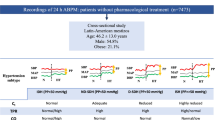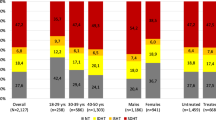Abstract
The central hemodynamic characteristics of young adults with isolated systolic hypertension (ISH) remain controversial, particularly regarding the extent of pulse pressure amplification (PPamp) compared with that of normotensives (NTs). Given the lack of ambulatory blood pressure monitoring (ABPM)-based data, this study evaluated 509 untreated young adults (18–35 years) who had undergone ABPM during the last decade, 109 who had undergone both ABPM and SphygmoCor analysis, and 26 newly recruited NTs. The agreement rate between office BP- and ABPM-based subtype classification was alarmingly low (50.7%). ISH was distinguishable from systolic–diastolic hypertension, the predominant subtype characterized by increased central BPs and stiffened arteries. The central hemodynamic parameters were all similar between patients with ISH and white-coat hypertension (WC). ISH patients had central BPs that were, albeit higher than those of NTs, at an upper-normal level that was comparable to those of WC patients. ISH patients had similar cfPWV but significantly higher PPamp than NTs (p = 0.032). The central hemodynamic parameters of the participants were further analyzed according to central pressure waveform types (A vs. B vs. C). Type C waves were associated with the highest PPamp and lowest cfPWV, whereas type A waves were associated with the lowest PPamp and highest cfPWV. Subjects with type B waves, an intermediate form, also had considerably high PPamps. Waveform composition differed significantly across hypertension subtypes (p < 0.001). ISH patients mostly had type B or C waves (96.7%), with only 3.3% having type A waves. This study based on a refined diagnosis showed that the ambulatory ISH of young adults arises from highly elastic arteries and related robustness of PPamp and shares similar central hemodynamic characteristics with WC patients.
This is a preview of subscription content, access via your institution
Access options
Subscribe to this journal
Receive 12 print issues and online access
$259.00 per year
only $21.58 per issue
Buy this article
- Purchase on Springer Link
- Instant access to full article PDF
Prices may be subject to local taxes which are calculated during checkout


Similar content being viewed by others
References
Grebla RC, Rodriguez CJ, Borrell LN, Pickering TG. Prevalence and determinants of isolated systolic hypertension among young adults: the 1999–2004 US National Health And Nutrition Examination Survey. J Hypertens. 2010;28:15–U15.
O’Rourke MF, Vlachopoulos C, Graham RM. Spurious systolic hypertension in youth. Vasc Med. 2000;5:141–5.
Mahmud A, Feely J. Spurious systolic hypertension of youth: fit young men with elastic arteries. Am J Hypertens. 2003;16:229–32.
McEniery CM, Yasmin, Wallace S, Maki-Petaja K, McDonnell B, Sharman JE, et al. Increased stroke volume and aortic stiffness contribute to isolated systolic hypertension in young adults. Hypertension. 2005;46:221–6.
McEniery CM, Franklin SS, Cockcroft JR, Wilkinson IB. Isolated systolic hypertension in young people is not spurious and should be treated: pro side of the argument. Hypertension. 2016;68:269–75.
Hulsen HT, Nijdam ME, Bos WJ, Uiterwaal CS, Oren A, Grobbee DE, et al. Spurious systolic hypertension in young adults; prevalence of high brachial systolic blood pressure and low central pressure and its determinants. J Hypertens. 2006;24:1027–32.
Whelton PK, Carey RM, Aronow WS, Casey DE Jr., Collins KJ, Dennison Himmelfarb C, et al. 2017 ACC/AHA/AAPA/ABC/ACPM/AGS/APhA/ASH/ASPC/NMA/PCNA guideline for the prevention, detection, evaluation, and management of high blood pressure in adults: a report of the American College of Cardiology/American Heart Association Task Force on Clinical Practice Guidelines. J Am Coll Cardiol. 2018;71:e127–248.
Krause T, Lovibond K, Caulfield M, McCormack T, Williams B. Management of hypertension: summary of NICE guidance. BMJ. 2011;343:d4891.
Siu AL, Force USPST. Screening for high blood pressure in adults: U.S. Preventive Services Task Force recommendation statement. Ann Intern Med. 2015;163:778–86.
Salvi P. Pulse waves: how vascular hemodynamics affects blood pressure. Germany: Springer International Publishing; 2017.
Murgo JP, Westerhof N, Giolma JP, Altobelli SA. Aortic input impedance in normal man—relationship to pressure wave forms. Circulation. 1980;62:105–16.
Herbert A, Cruickshank JK, Laurent S, Boutouyrie P. Reference values for arterial measurements C. Establishing reference values for central blood pressure and its amplification in a general healthy population and according to cardiovascular risk factors. Eur Heart J. 2014;35:3122–33.
O’Brien E, Parati G, Stergiou G, Asmar R, Beilin L, Bilo G, et al. European society of hypertension position paper on ambulatory blood pressure monitoring. J Hypertens. 2013;31:1731–68.
Piper MA, Evans CV, Burda BU, Margolis KL, O’Connor E, Whitlock EP. Diagnostic and predictive accuracy of blood pressure screening methods with consideration of rescreening intervals: a systematic review for the U.S. Preventive Services Task Force. Ann Intern Med. 2015;162:192–204.
Schwartz JE, Burg MM, Shimbo D, Broderick JE, Stone AA, Ishikawa J, et al. Clinic blood pressure underestimates ambulatory blood pressure in an untreated employer-based us population: results from the masked hypertension study. Circulation. 2016;134:1794–807.
Conen D, Aeschbacher S, Thijs L, Li Y, Boggia J, Asayama K, et al. Age-specific differences between conventional and ambulatory daytime blood pressure values. Hypertension. 2014;64:1073–9.
Li Y, Wei FF, Thijs L, Boggia J, Asayama K, Hansen TW, et al. Ambulatory hypertension subtypes and 24-hour systolic and diastolic blood pressure as distinct outcome predictors in 8341 untreated people recruited from 12 populations. Circulation. 2014;130:466–74.
Palatini P, Saladini F, Mos L, Fania C, Mazzer A, Casiglia E. Clinical characteristics and risk of hypertension needing treatment in young patients with systolic hypertension identified with ambulatory monitoring. J Hypertens. 2018;36:1810–5.
Mayet J, Hughes A. Cardiac and vascular pathophysiology in hypertension. Heart. 2003;89:1104–9.
Kaess BM, Rong J, Larson MG, Hamburg NM, Vita JA, Levy D, et al. Aortic stiffness, blood pressure progression, and incident hypertension. JAMA. 2012;308:875–81.
Oh YS, Berkowitz DE, Cohen RA, Figueroa CA, Harrison DG, Humphrey JD, et al. A special report on the NHLBI initiative to study cellular and molecular mechanisms of arterial stiffness and its association with hypertension. Circ Res. 2017;121:1216–8.
Wilkinson IB, MacCallum H, Flint L, Cockcroft JR, Newby DE, Webb DJ. The influence of heart rate on augmentation index and central arterial pressure in humans. J Physiol. 2000;525(Pt 1):263–70.
Albaladejo P, Copie X, Boutouyrie P, Laloux B, Declere AD, Smulyan H, et al. Heart rate, arterial stiffness, and wave reflections in paced patients. Hypertension. 2001;38:949–52.
Laurent P, Albaladejo P, Blacher J, Rudnichi A, Smulyan H, Safar ME. Heart rate and pulse pressure amplification in hypertensive subjects. Am J Hypertens. 2003;16:363–70.
Avolio AP, Van Bortel LM, Boutouyrie P, Cockcroft JR, McEniery CM, Protogerou AD, et al. Role of pulse pressure amplification in arterial hypertension experts’ opinion and review of the data. Hypertension. 2009;54:375–83.
Williams B, Lacy PS, CAFE and the ASCOT (Anglo-Scandinavian Cardiac Outcomes Trial) Investigators. Impact of heart rate on central aortic pressures and hemodynamics: analysis from the CAFE (Conduit Artery Function Evaluation) study: CAFE-Heart Rate. J Am Coll Cardiol. 2009;54:705–13.
Avolio AP, Van Bortel LM, Boutouyrie P, Cockcroft JR, McEniery CM, Protogerou AD, et al. Role of pulse pressure amplification in arterial hypertension: experts’ opinion and review of the data. Hypertension. 2009;54:375–83.
Murgo JP, Westerhof N, Giolma JP, Altobelli SA. Manipulation of ascending aortic pressure and flow wave reflections with the Valsalva maneuver: relationship to input impedance. Circulation. 1981;63:122–32.
Wilkinson IB, Mohammad NH, Tyrrell S, Hall IR, Webb DJ, Paul VE, et al. Heart rate dependency of pulse pressure amplification and arterial stiffness. Am J Hypertens. 2002;15(1 Pt 1):24–30.
Owens P, Atkins N, O’Brien E. Diagnosis of white coat hypertension by ambulatory blood pressure monitoring. Hypertension. 1999;34:267–72.
Prasad N, MacFadyen RJ, Ogston SA, MacDonald TM. Elevated blood pressure during the first two hours of ambulatory blood pressure monitoring: a study comparing consecutive twenty-four-hour monitoring periods. J Hypertens. 1995;13:291–5.
Yano Y, Stamler J, Garside DB, Daviglus ML, Franklin SS, Carnethon MR, et al. Isolated systolic hypertension in young and middle-aged adults and 31-year risk for cardiovascular mortality the Chicago Heart Association Detection Project in Industry Study. J Am Coll Cardiol. 2015;65:327–35.
Bursztyn M. Isolated systolic hypertension in young adults: a heterogeneous finding. J Hypertens. 2018;36:1791–2.
Franklin SS, Thijs L, Asayama K, Li Y, Hansen TW, Boggia J, et al. The cardiovascular risk of white-coat hypertension. J Am Coll Cardiol. 2016;68:2033–43.
Mancia G, Grassi G. The heterogeneous nature of white-coat hypertension. J Am Coll Cardiol. 2016;68:2044–6.
Mancia G, Bombelli M, Cuspidi C, Facchetti R, Grassi G. Cardiovascular risk associated with white-coat hypertension: pro side of the argument. Hypertension. 2017;70:668–75.
Mancia G, Bombelli M, Facchetti R, Madotto F, Quarti-Trevano F, Polo Friz H, et al. Long-term risk of sustained hypertension in white-coat or masked hypertension. Hypertension. 2009;54:226–32.
Davis EF, Lewandowski AJ, Aye C, Williamson W, Boardman H, Huang RC, et al. Clinical cardiovascular risk during young adulthood in offspring of hypertensive pregnancies: insights from a 20-year prospective follow-up birth cohort. BMJ Open. 2015;5:e008136.
Acknowledgements
This work was in part supported by the year 2018 research grant from Korea University Ansan Hospital.
Author information
Authors and Affiliations
Corresponding author
Ethics declarations
Conflict of interest
The authors declare that they have no conflict of interest.
Additional information
Publisher’s note Springer Nature remains neutral with regard to jurisdictional claims in published maps and institutional affiliations.
Supplementary information
Rights and permissions
About this article
Cite this article
Kim, S., Lee, JS., Kim, W. et al. Central hemodynamic characteristics of young adults with isolated systolic hypertension: an ambulatory blood pressure monitoring-based study of real-world clinical patients. Hypertens Res 43, 197–206 (2020). https://doi.org/10.1038/s41440-019-0352-1
Received:
Revised:
Accepted:
Published:
Issue Date:
DOI: https://doi.org/10.1038/s41440-019-0352-1
Keywords
This article is cited by
-
Association of waist-to-height ratio with hypertension and its subtypes in southern China
Journal of Human Hypertension (2022)



